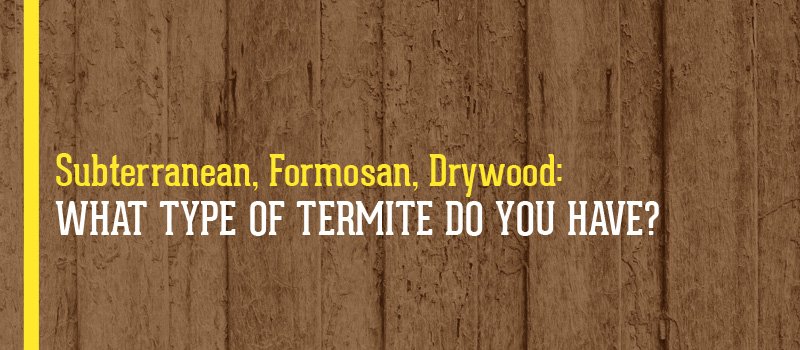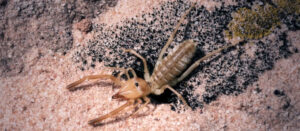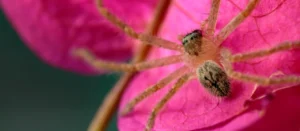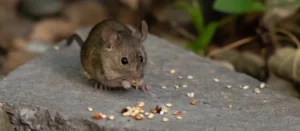Formosan, Drywood, Dampwood: Which Type of Termite Do You Have?

Unfortunately, termites aren’t just one insect. There are many different termite species, which will differ depending on where your home is located. Although each species has different characteristics, the one thing they all have in common is the ability to cause severe structural damage to your home.
The five most common types of termites include Dampwood, Drywood, Formosan, Subterranean, and Conehead. If you’re worried you may have a termite infestation, there are different signs depending on the type of termite you have. Knowing the differences between the species of termites can help you quickly recognize any signs of damage and allow you to expedite the extermination process.
Dampwood Termites
Dampwood termites are aptly named because they are drawn to damp, decaying wood to form their colonies. Unlike Subterranean termites, Dampwood termites do not nest in the soil, however, they will invade wood that is placed on the ground, especially if it is decaying. Dampwood termites are one of the larger species of termites, with the swarmers reaching 25 mm long, and the “soldiers” being as large as 20 mm. You can tell the Dampwood termites apart from some of the other species by their heads, which are large and have pinchers on the front. The most common place to find this particular species of termite is along the Pacific Coast, the Southwest desert, and southern Florida.
Drywood Termites
Breaking the typical pattern of other species of termites, the Drywood termites need very little moisture, hence the name “Drywood.” Their colonies are usually formed in wood – most commonly, wood found in attics – and they don’t need to have any contact with the soil around your home. Since these termites aren’t as attracted to moisture, they actually extract water from their feces in order to conserve it, and then push the pellets out of their tunnel. These fecal pellets are called frass, and mounds of these (which look like piles of coffee grounds) in your home indicate termite activity.
Formosan Termites
Commonly found across the South, the Formosan termites prefer warm climates. They are usually located in Alabama, Florida, Georgia, Mississippi, South Carolina, North Carolina, Texas, and Tennessee, but have also been found in California, Hawaii, and even as far north as the Canadian border. Unlike Drywood termites, Formosan termites nest in the soil and invade homes from the soil directly through “wood to ground contact.” They also commonly build mud tubes from soil and use those as a duct to get into structures. The queen in the colony can produce more than 1,000 eggs per day, and they eventually swarm to create new colonies. Common signs of damage from Formosan termites include sagging walls and plaster and wood that appears to have been sanded down. Luckily, for now, we do not have Formosan termites here in Phoenix, Arizona. The desert heat and lack of moisture are difficult environments for Formosan termites.
Subterranean Termites
Subterranean termites are the most common type of termite found across the country. The desert subterranean termite is the termite we treat for 99% of the time here in the Phoenix, Arizona area. They live in colonies underground and build tunnels into structures in search of food. They also build mud tubes like the Formosan termites, and their diets consist of wood and other cellulose material – including carpets. There are three “castes” of a Subterranean termite colony, with each caste differing in size and defining features. The “workers” are 6 mm long and light-colored and wingless. The “soldiers” of the colony have pinchers and long heads. The “reproductives” are dark in color and they have two pairs of wings that are equal in length.
When warm temperatures and heavy rainfall occur, these guys send out a swarm of winged termites that include males and females. A common mistake many homeowners make is misidentifying a flying ant as a subterranean termite and vice versa. A good way to be sure to tell the difference is to check the wings. Flying ants have two large wings in front and two smaller wings behind, but termites have four wings that are all the same size, resembling fish scales. You’ll know if you have a termite infestation in your home if you find piles of these wings in your home, particularly in windowsills.
Conehead Termites
Conehead termites get their name because the “soldiers” have a dark, cone-shaped head. These soldiers make up about 20 percent to 30 percent of the entire Conehead colony, whereas soldiers in Subterranean and Drywood colonies only make up about 2 percent. These particular termites are most commonly found in the Caribbean and Central American tropical countries, such as Panama, however, since 2001, they have also been found in the most southern part of Florida. Conehead termites usually infest and consume shrubs, trees, roots, fence posts, furniture, and paper products, as well as anything that contains cellulose.
Conehead tunnels also look different than the typical mud tunnels of the Subterranean termites. Conehead tunnels are larger, wider, and more extensive, and they create nests in trees that are out in the open. The nest looks like a large, bumpy brown ball, almost like a beehive. Contact us to get a free termite inspection anywhere in the Phoenix area including Gilbert, Surprise, and Mesa! We do commercial and residential termite control!


